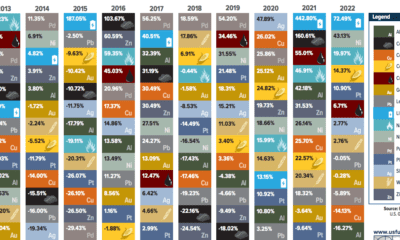The FAANG stocks alone have gained over $1 trillion in market capitalization since 2014 – and these stocks, along with other tech movers and shakers, have helped propel indices to constant new highs.
Growing Competition
While tech shows no signs of letting up on its dominance over markets, investors should know about two other multi-billion dollar sectors nipping at its heels. In today’s infographic, done in conjunction with SmallCapPower, we’ve highlighted the macro investment cases behind tech as well as these other high-growth areas: battery metals and cannabis. For those interested, they’ve also published a watch list of nine stocks with double or triple-digit growth in these sectors. The infographic highlights three of the top performing stocks in these sectors YTD. Don’t forget to see the full list of nine stocks.
Secular Trends
Like technology, the battery metals and cannabis sectors have upside attached to secular trends that are changing our world. Technology: “Software is eating the world” Battery Metals: The green energy revolution Cannabis: Legalization and decriminalization of cannabis products As a result, all of these sectors are poised to continue expanding at rapid rates: It’s worth mentioning that above projections are based on the overall IT sector, the rechargeable batteries market, and the legal cannabis market. Further, it’s also important to recognize that individual subsectors within tech are growing much faster than the overall market as a whole, such as the blockchain, IoT, cybersecurity, SaaS, AI, and VR/AR.
Sustainable Growth Drivers?
While there’s no shortage of hype around tech, battery metals, or cannabis, it is also clear that all of these markets will only grow in importance over time. In technology, for example, the slower-moving verticals like healthcare, government, finance, and education are only starting to get disrupted. The blockchain is in its early days and will touch many aspects of life, and AI alone is expected to have a $15.7 trillion impact by 2030. Meanwhile, the green revolution is driving the future importance of battery metals like lithium, cobalt, nickel, and graphite. As EV penetration grows, so does lithium-ion battery use – and these metals are all needed to make them work. Finally, the trajectory of legalized cannabis seems difficult to stop. In multiple states, cannabis is already available for recreational use – and in recently-legalized places like Canada and California, the recreational shops will open up very soon. However, the cannabis industry is still in its infancy, and many millions of people are still expected to gain access yet. This, like the other two industries, creates a fast-growing opportunity for both business and investors. on But fast forward to the end of last week, and SVB was shuttered by regulators after a panic-induced bank run. So, how exactly did this happen? We dig in below.
Road to a Bank Run
SVB and its customers generally thrived during the low interest rate era, but as rates rose, SVB found itself more exposed to risk than a typical bank. Even so, at the end of 2022, the bank’s balance sheet showed no cause for alarm.
As well, the bank was viewed positively in a number of places. Most Wall Street analyst ratings were overwhelmingly positive on the bank’s stock, and Forbes had just added the bank to its Financial All-Stars list. Outward signs of trouble emerged on Wednesday, March 8th, when SVB surprised investors with news that the bank needed to raise more than $2 billion to shore up its balance sheet. The reaction from prominent venture capitalists was not positive, with Coatue Management, Union Square Ventures, and Peter Thiel’s Founders Fund moving to limit exposure to the 40-year-old bank. The influence of these firms is believed to have added fuel to the fire, and a bank run ensued. Also influencing decision making was the fact that SVB had the highest percentage of uninsured domestic deposits of all big banks. These totaled nearly $152 billion, or about 97% of all deposits. By the end of the day, customers had tried to withdraw $42 billion in deposits.
What Triggered the SVB Collapse?
While the collapse of SVB took place over the course of 44 hours, its roots trace back to the early pandemic years. In 2021, U.S. venture capital-backed companies raised a record $330 billion—double the amount seen in 2020. At the time, interest rates were at rock-bottom levels to help buoy the economy. Matt Levine sums up the situation well: “When interest rates are low everywhere, a dollar in 20 years is about as good as a dollar today, so a startup whose business model is “we will lose money for a decade building artificial intelligence, and then rake in lots of money in the far future” sounds pretty good. When interest rates are higher, a dollar today is better than a dollar tomorrow, so investors want cash flows. When interest rates were low for a long time, and suddenly become high, all the money that was rushing to your customers is suddenly cut off.” Source: Pitchbook Why is this important? During this time, SVB received billions of dollars from these venture-backed clients. In one year alone, their deposits increased 100%. They took these funds and invested them in longer-term bonds. As a result, this created a dangerous trap as the company expected rates would remain low. During this time, SVB invested in bonds at the top of the market. As interest rates rose higher and bond prices declined, SVB started taking major losses on their long-term bond holdings.
Losses Fueling a Liquidity Crunch
When SVB reported its fourth quarter results in early 2023, Moody’s Investor Service, a credit rating agency took notice. In early March, it said that SVB was at high risk for a downgrade due to its significant unrealized losses. In response, SVB looked to sell $2 billion of its investments at a loss to help boost liquidity for its struggling balance sheet. Soon, more hedge funds and venture investors realized SVB could be on thin ice. Depositors withdrew funds in droves, spurring a liquidity squeeze and prompting California regulators and the FDIC to step in and shut down the bank.
What Happens Now?
While much of SVB’s activity was focused on the tech sector, the bank’s shocking collapse has rattled a financial sector that is already on edge.
The four biggest U.S. banks lost a combined $52 billion the day before the SVB collapse. On Friday, other banking stocks saw double-digit drops, including Signature Bank (-23%), First Republic (-15%), and Silvergate Capital (-11%).
Source: Morningstar Direct. *Represents March 9 data, trading halted on March 10.
When the dust settles, it’s hard to predict the ripple effects that will emerge from this dramatic event. For investors, the Secretary of the Treasury Janet Yellen announced confidence in the banking system remaining resilient, noting that regulators have the proper tools in response to the issue.
But others have seen trouble brewing as far back as 2020 (or earlier) when commercial banking assets were skyrocketing and banks were buying bonds when rates were low.













